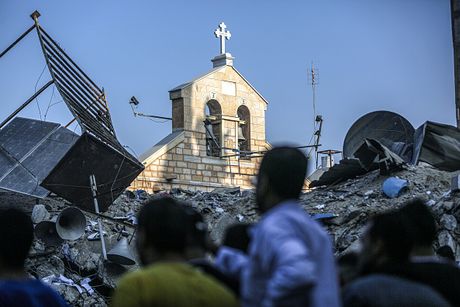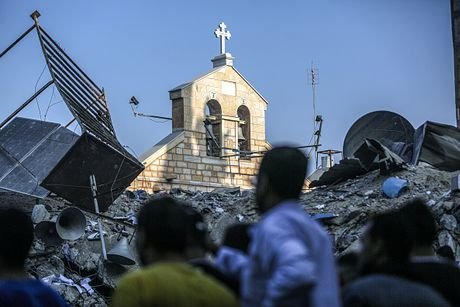
The Greek Orthodox Church of Saint Porphyrius in Gaza, believed to be the third oldest church in the world, was hit by missiles on Thursday night as hundreds of Palestinians sought shelter there. According to the Orthodox Patriarchate of Jerusalem and Palestinian health officials, at least 18 Christian Palestinians were killed and there are reports that dozens are still trapped under the rubble. In a statement on its official website, the church claimed Israel was responsible for the strikes; the Israeli military subsequently claimed responsibility for the blast, according to Wall Street Journal.
According to the Order of St George, an advocacy organisation for Orthodox Christians in the Middle East, “Archbishop Alexios [who belongs to the Church of Saint Porphyrius] appears to have been located and is alive, but we don’t know if he is injured. We have no word on the condition of any other of the more than 500 people being housed at the church and monastery.”
The church is located in the Zaytun Quarter of Gaza’s Old City, with the tomb of its namesake, Saint Porphyrius—the fifth-century bishop of Gaza— housed in its northeastern corner. Born in Thessaloniki in AD374, Saint Porphyrius was bishop of Gaza from AD395 to AD 420 and known from a biography by Roman Christian hagiographer Mark the Deacon for Christianising the “recalcitrant pagan city of Gaza” and demolishing its temples.
In an initial statement, the Israel Defense Forces (IDF) said its fighter jets had hit a nearby command-and-control centre that was used to carry out attacks against Israel. “As a result of the IDF strike, a wall of a church in the area was damaged. We are aware of reports on casualties,” it said.
The church is an important site for Christians in the Gaza Strip, who make up an estimated 1,000 people—most of them Greek Orthodox—of the enclave’s total population of 2.3 million. But it has long been a sanctuary for Muslims, too. During the IDF’s bombing campaign in the Gaza Strip in July 2014, a period when Ramadan prayers were being held in the ancient church’s courtyard, the site was hit by Israeli tank shells, with water tanks blown up and a neighbouring house belonging to the church left damaged. Yesterday’s blast also damaged an adjoining building.
St Porphyrios church, which dates back to AD407, was converted into a mosque in the seventh century. A new church was built in the 12th century by crusaders. It was last renovated in 1856; today, only a few cornices and bases remain from the crusader period.
The church shares architectural similarities with the Great Mosque of Gaza in Jabaliya, northern Gaza, which according to a statement by Gaza’s interior ministry and as reported by Turkey’s new agency Anadolu was also destroyed earlier today by IDF bombing. The mosque was formerly the Cathedral of Saint John the Baptist, believed to have been erected on the site of a former Philistine temple in the fifth century and then converted into a mosque after the seventh-century Muslim conquest.
In its statement on its website, the Greek Orthodox Patriarchate of Jerusalem expressed its “strongest condemnation” of yesterday’s strike on St Porphyrius church.
“Targeting churches and their institutions, along with the shelters they provide to protect innocent citizens, especially children and women who have lost their homes due to Israeli airstrikes on residential areas over the past 13 days, constitutes a war crime that cannot be ignored,” the patriarchate said in a statement.
There are currently three world heritage sites listed by Unesco in Gaza, including the fourth century St Hilarion Monastery located on the archaeological sites of Tell Umm el’Amr, eight miles south of Gaza City.










